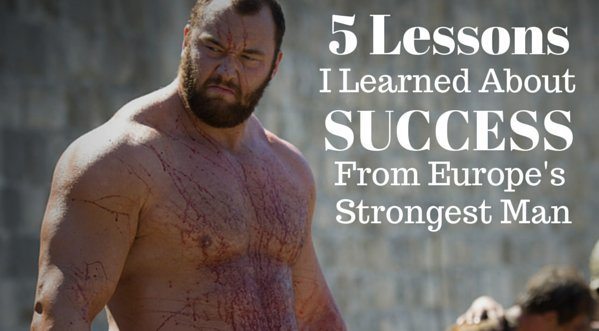Success Advice
5 Lessons I Learned About Success From Europe’s Strongest Man

As many of you know, season 5 of Game of Thrones is starting soon. In my nerdy excitement, I started reading about the guy who plays The Mountain, Hafthor Bjornsson.
It turns out this guy who crushes skulls on TV is also officially Europe’s Strongest Man.
As I watched this behemoth lift immensely heavy weights, I realized that he actually has a lot to teach us entrepreneurs about success.
But first, just to give you some context for how freakishly strong Bjornsson is in real-life…
- He can bench press 510 pounds, squat 770 pounds and deadlift 925 pounds.
- He recently broke a 1,000 year-old strongman record by carrying a 1,433 pound log on his back for 5 steps
- He’s been Iceland’s strongest man for four straight years, and has a good shot of winning the Arnold Strongman Classic this year (one of the most competitive strongman events in the world).
Even if you know nothing about health or fitness, you can probably tell that this is a man who has mastered his craft.
What Can We Learn about Success from Europe’s Strongest Man?
At 26 years-old, Bjornsson is a strongman prodigy. As you continue reading, you’ll learn how you can use the same principles and philosophies that he’s applied to strength training to become a better, more effective entrepreneur.
Lesson 1. Make Your Habits Match Your Goals
If you watch any of Hafthor’s Youtube videos (here’s his channel):
You’ll see a recurring theme – he only does exercises that have a direct correlation with a strongman event. That means he only lifts really heavy weights and focuses primarily on developing his legs and shoulders.
Why?
Because he’s training for a competition where the goal is to lift really heavy stuff with his legs and shoulders.
Pretty straightforward when you think about it. But, what does this mean for us entrepreneurs?
It means that you need to take a careful look at your goals compared to your daily habits. Make sure that what you do on a daily basis directly relates to the specific goals you want to achieve.
For example, if you want to build the most popular blog in your niche, then you should probably focus the majority of your effort on creating better, more helpful and more engaging content than your competition and telling as many people about it as possible. If every single thing you do during your work day doesn’t align with one of those two objectives, cut it out.
Lesson 2. Be Overconfident
I’ve talked to way too many timid entrepreneurs; more than I can count. These are people who have a truly great idea, but they’re just too afraid to get out and make it happen.
After Bjornsson broke the 1,000 year Icelandic log-carry record, he shared his opinion of himself with a post on Instagram: “NOTHING CAN STOP ME!! NOTHING CAN BREAK ME!!”
He’s made a similar proclamation after winning Europe’s Strongest Man: “I… AM THE FUTURE… OF STRENGTHHHH!!!!!”
Yeah, pretty intense guy, but that’s the kind of mentality you need to be the best.
Nothing can stop you.
Nothing can break you.
You have to tell yourself that you’re the best even before you’ve gotten there. Plus, if you’re putting in the hours into endeavors that directly align with your goals, then there really is nothing that can stop you.
Which brings us to…
Lesson 3. There’s No Such Thing as a Setback
At 6’ 9” tall and over 400 lbs., it’s obvious that Bjornsson is well-suited for lifting heavy stuff, but he wasn’t always a strongman.
He actually grew up playing basketball. In fact, he was a starting center for the D2 Icelandic National Basketball Team in 2006-07, and then he played on a professional team called FSu Selfoss from 2007 to 2008.
Unfortunately, just as his professional basketball career was starting to take off, he sustained a debilitating knee injury that put an abrupt end to his dreams of playing pro ‘ball. Losing even a few months for recovery in such a competitive sport is a literal death blow to any possible career.
And yet, despite the knee injury, Bjornsson wasn’t done showing the world what he could do. Later that year he met an old-time Icelandic strongman legend, Magnus Ver Magnusson, who convinced him to give strongman competitions a try.
Two years later he was the Strongest Man in Iceland. Six years later he was Europe’s Strongest Man. This teaches us one very important lesson about setbacks…
There’s no such thing as failure; just doorways to new, better opportunities.
Lesson 4. Leverage Your Unique Talents
This brings us to another point, which is that Bjornsson latched onto something he was good at and never looked back.
Think about it… There’s no doubt that he made less money in those intermittent two years between his basketball career and strongman career. Yet he stuck with what he knew he was good at and it paid off big time.
All of us have something that we’re really, really good at…
- Maybe you’re really good at writing engaging content
- Maybe you’re really good at finding profitable niches or keywords
- Maybe you have a knack for project management or working with contractors
- Maybe building an audience on social networks is one of those things you “just get” how to do
Either way, figure out what your natural strengths are, and then never let those talents out of your sight.
Hone your strengths until you’re so good at what you do that it eclipses your weaknesses.
Lesson 5. Work Hard & Conquer
Above all, the lesson to be learned from Bjornsson’s immense success in the strength training world is that hard work pays off.
There isn’t a moment of any day that goes by where Bjornsson isn’t thinking about his goal – to be the strongest man in the world.
Everything he does throughout each day is geared toward this one goal. What he eats (all 8,000 calories of it), how much he sleeps, how and when he trains, who he talks to… These are all 100% optimized to enable him to work as hard as possible, recover as fast as possible and compete at the highest level possible.
Do you have this same laser-like focus?
Do you have this same undying work ethic?
If not, what’s holding you back? What habits, people or problems are keeping you from devoting yourself to your goal?
Do you even know what that one goal is?
When you can answer these questions, you’ll be able to achieve the same success with your startup that Bjornsson’s achieved in strongman.
Success Advice
Why One-Size-Fits-All Leadership Will Always Fail (and What Works Instead)
The surprising truth about leadership styles that can make or break your team’s success.

Leadership has always been as much about people as it is about performance. Ken Blanchard, in his influential book, “The One Minute Manager”, put it simply: different strokes for different folks. (more…)
Success Advice
What Every New CEO Must Do in Their First 100 Days (or Risk Failure)
Your first 100 days as CEO could define your entire legacy, here’s how to make every move count

When Tim Cook took over from Steve Jobs at Apple, the world watched with bated breath. Jobs wasn’t just a CEO; he was a visionary, an icon, and a legend of innovative leadership. (more…)
Entrepreneurs
The Leadership Shift Every Company Needs in 2025
Struggling to keep your team engaged? Here’s how leaders can turn frustrated employees into loyal advocates.

In workplaces around the world, there’s a growing gap between employers and employees and between superiors and their teams. It’s a common refrain: “People don’t leave companies, they leave bad bosses.”
While there are, of course, cases where management could do better, this isn’t just a “bad boss” problem. The relationship between leaders and employees is complex. Instead of assigning blame, we should explore practical solutions to build stronger, healthier workplaces where everyone thrives.
Why This Gap Exists
Every workplace needs someone to guide, supervise, and provide feedback. That’s essential for productivity and performance. But because there are usually far more employees than managers, dissatisfaction, fair or not, spreads quickly.
What if, instead of focusing on blame, we focused on building trust, empathy, and communication? This is where modern leadership and human-centered management can make a difference.
Tools and Techniques to Bridge the Gap
Here are proven strategies leaders and employees can use to foster stronger relationships and create a workplace where people actually want to stay.
1. Practice Mutual Empathy
Both managers and employees need to recognize they are ultimately on the same team. Leaders have to balance people and performance, and often face intense pressure to hit targets. Employees who understand this reality are more likely to cooperate and problem-solve collaboratively.
2. Maintain Professional Boundaries
Superiors should separate personal issues from professional decision-making. Consistency, fairness, and integrity build trust, and trust is the foundation of a motivated team.
3. Follow the Golden Rule
Treat people how you would like to be treated. This simple principle encourages compassion and respect, two qualities every effective leader must demonstrate.
4. Avoid Micromanagement
Micromanaging stifles creativity and damages morale. Great leaders see themselves as partners, not just bosses, and treat their teams as collaborators working toward a shared goal.
5. Empower Employees to Grow
Empowerment means giving employees responsibility that matches their capacity, and then trusting them to deliver. Encourage them to take calculated risks, learn from mistakes, and problem-solve independently. If something goes wrong, turn it into a learning opportunity, not a reprimand.
6. Communicate in All Directions
Communication shouldn’t just be top-down. Invite feedback, create open channels for suggestions, and genuinely listen to what your people have to say. Healthy upward communication closes gaps before they become conflicts.
7. Overcome Insecurities
Many leaders secretly fear being outshone by younger, more tech-savvy employees. Instead of resisting, embrace the chance to learn from them. Humility earns respect and helps the team innovate faster.
8. Invest in Coaching and Mentorship
True leaders grow other leaders. Provide mentorship, career guidance, and stretch opportunities so employees can develop new skills. Leadership is learned through experience, but guided experience is even more powerful.
9. Eliminate Favoritism
Avoid cliques and office politics. Decisions should be based on facts and fairness, not gossip. Objective, transparent decision-making builds credibility.
10. Recognize Efforts Promptly
Recognition often matters more than rewards. Publicly appreciate employees’ contributions and do so consistently and fairly. A timely “thank you” can be more motivating than a quarterly bonus.
11. Conduct Thoughtful Exit Interviews
When employees leave, treat it as an opportunity to learn. Keep interviews confidential and use the insights to improve management practices and culture.
12. Provide Leadership Development
Train managers to lead, not just supervise. Leadership development programs help shift mindsets from “command and control” to “coach and empower.” This transformation has a direct impact on morale and retention.
13. Adopt Soft Leadership Principles
Today’s workforce, largely millennials and Gen Z, value collaboration over hierarchy. Soft leadership focuses on partnership, mutual respect, and shared purpose, rather than rigid top-down control.
The Bigger Picture: HR’s Role
Mercer’s global research highlights five key priorities for organizations:
-
Build diverse talent pipelines
-
Embrace flexible work models
-
Design compelling career paths
-
Simplify HR processes
-
Redefine the value HR brings
The challenge? Employers and employees often view these priorities differently. Bridging that perception gap is just as important as bridging the relational gap between leaders and staff.
Treat Employees Like Associates, Not Just Staff
When you treat employees like partners, they bring their best selves to work. HR leaders must develop strategies to keep talent engaged, empowered, and prepared for the future.
Organizational success starts with people, always. Build the relationship with your team first, and the results will follow.
Entrepreneurs
What Makes an Entrepreneurial Leader? Traits of the World’s Best Innovators
Inside the mindset of entrepreneurial leaders who transform risk, passion, and vision into world-changing results.

When you think of Richard Branson (Virgin Group), Bill Gates (Microsoft), Steve Jobs (Apple), Rupert Murdoch (News Corporation), and Ted Turner (CNN), one thing becomes clear: they are not just entrepreneurs, they are entrepreneurial leaders. (more…)
-

 Change Your Mindset4 weeks ago
Change Your Mindset4 weeks agoWhy Ideas Are More Valuable Than Resources for Entrepreneurial Success
-

 Entrepreneurs4 weeks ago
Entrepreneurs4 weeks agoBuilding a Business Empire: Lessons from the World’s Boldest Entrepreneurs
-

 Health & Fitness3 weeks ago
Health & Fitness3 weeks agoThe Surprising Link Between Exercise and Higher Income
-

 Entrepreneurs3 weeks ago
Entrepreneurs3 weeks agoWhat Makes an Entrepreneurial Leader? Traits of the World’s Best Innovators
-

 Entrepreneurs2 weeks ago
Entrepreneurs2 weeks agoThe Leadership Shift Every Company Needs in 2025
-

 Change Your Mindset2 weeks ago
Change Your Mindset2 weeks ago7 Goal-Setting Mistakes That Are Secretly Sabotaging Your Success
-

 Success Advice1 week ago
Success Advice1 week agoWhat Every New CEO Must Do in Their First 100 Days (or Risk Failure)
-

 Success Advice4 days ago
Success Advice4 days agoWhy One-Size-Fits-All Leadership Will Always Fail (and What Works Instead)


























7 Comments